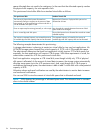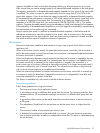Optimizing replication performance
Planning for host I/O workloads
For the best snapshot and snapclone performance, create and delete snapshots and snapclones
during low-demand periods for host I/O, or configure the array to meet performance demands
during snapshot and snapclone activities.
• Snapshot and synchronized mirrorclone activity is driven by the host I/O and must compete
with the I/O workload on the disks.
• Snapclones and fractured mirrorclones operate independently of host I/O workload. That is,
the snapclone copy operation is initiated by the snapclone request (not by host I/O activity).
HP recommends that you plan the migration of virtual disks in advance because migration involves
the creation of a mirrorclone in the background which can compete with other I/O activity.
Optimizing snap creation
To optimize snap creation with a pre-allocated snapshot or snapclone:
1. Create a container that has the same capacity as the parent virtual disk as follows:
ADD CONTAINER container_name diskgroup=disk_group_name size=size
redundancy=vraid_level.
Repeat for all virtual disks that have a point-in-time copy.
2. Prepare the empty container by using one of the following commands:
• SET MULTISNAP prepare vdisk=vdisk_name container=container_name
snaptype
• SET VDISK container_nameprepare vdisk=vdisk_name snaptype
3. Flush the cache as follows:
SET VDISK vdisk_name writecache=writethrough.
Repeat for all virtual disks that have a point-in-time copy.
4. Quiesce the I/O throughout your application.
5. Create the snapshot or snapclone by using one of the following commands:
• ADD MULTISNAP snapshot_name vdisk=vdisk_name
container=container_name snaptype
• ADD SNAPSHOT snapshot_name vdisk=vdisk_name
container=container_name
Using containers (preallocation)
There are three steps to the creation of a snapclone or snapshot:
1. Metadata management—The preallocation of internal data structures of the snapshot or
snapclone
2. Write cache flush—The array's write cache is flushed to ensure that the data on the source
virtual disk is current before the disk is copied
3. Data movement—The copying of the data
When you create (preallocate) a container, the first step of snapshot or snapclone creation (metadata
management) is completed ahead of time. Therefore, when you eventually create a snapshot or
snapclone using the container, that first step is eliminated, which saves time. Using preallocated
containers greatly improves system response. If you create containers during low-demand periods,
you can further reduce the impact on the system workload.
40 Replicating storage


















